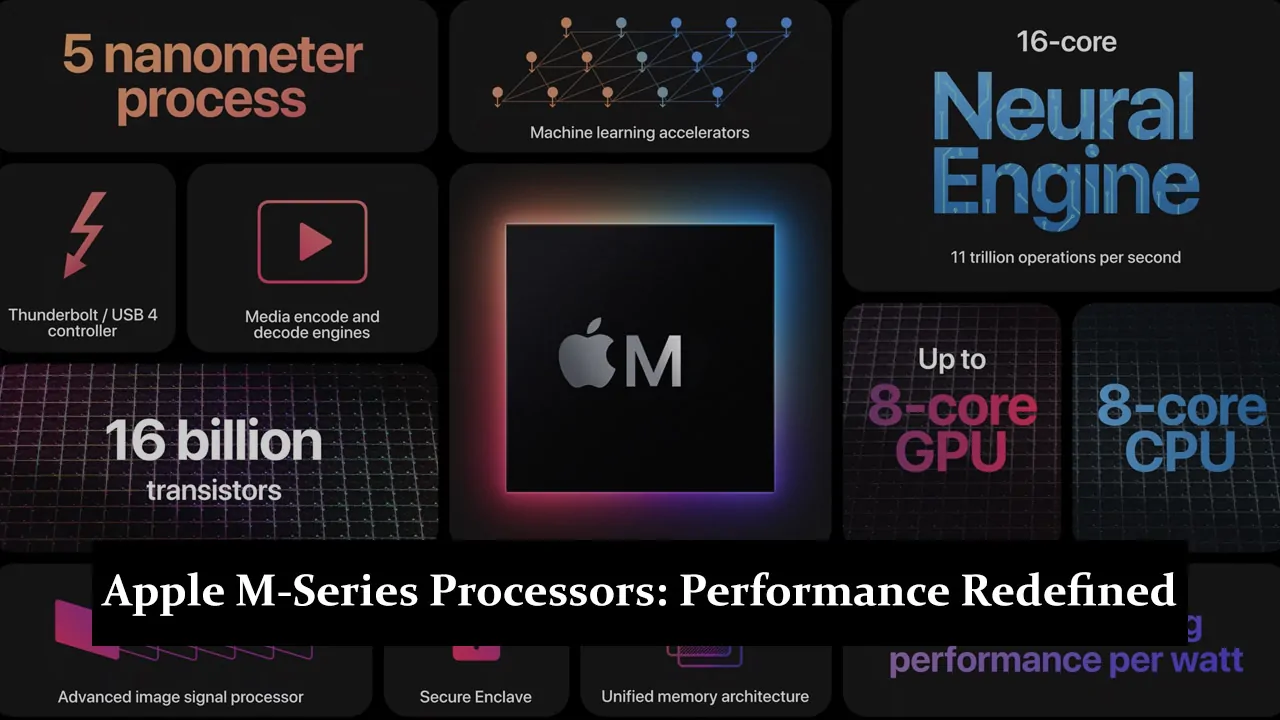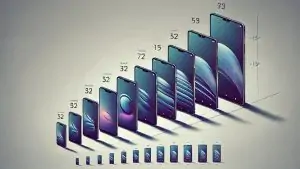Apple’s M-Series processors mark a significant shift from Intel-based chips to in-house silicon, revolutionising the performance and efficiency of Apple devices. These processors are designed specifically for the Mac lineup, offering superior power management and faster speeds, enhancing the overall user experience. The transition to M-series chips has been a critical move in Apple’s ecosystem, providing seamless integration across its devices. This shift highlights Apple’s commitment to pushing the boundaries of performance while maintaining energy efficiency, setting a new standard in computing technology.
Versions of Apple M-Series Processors
Apple M1: The First of the M-Series and Its Initial Impact
The Apple M1 processor was Apple’s first custom-designed silicon, debuting in 2020. It delivered remarkable improvements in speed, power efficiency, and integration with macOS. With an 8-core CPU and up to 8-core GPU, the M1 transformed the performance of Macs, offering faster processing and longer battery life. It allowed Apple to design lighter and quieter devices without compromising power. The M1’s impact was immediate, making it a milestone in computing history.
Apple M1 Pro and Apple M1 Max: Enhancements for Professional Use
The Apple M1 Pro and Apple M1 Max followed as powerful upgrades, catering to professional users with more demanding workflows. The M1 Pro introduced up to 10-core CPUs and 16-core GPUs, while the M1 Max took it further with up to 32 GPU cores. These chips featured faster memory and higher bandwidth, allowing for fluid multitasking, high-resolution video editing, and advanced 3D rendering. Both mobile processors expanded the M1 architecture’s capabilities, bringing pro-level performance to creatives and developers.
Apple M1 Ultra: Merging Two M1 Max Chips for Extreme Performance
The Apple M1 Ultra was a major leap, combining two M1 Max chips using Apple’s UltraFusion technology. This setup created an incredibly powerful processor with a 20-core CPU and up to 64-core GPU, offering unmatched performance for the most intensive tasks. The M1 Ultra’s extreme power was ideal for high-end content creators, engineers, and data scientists. Despite its immense power, it maintained the energy efficiency Apple’s silicon is known for, ensuring smooth, quiet performance.
Apple M2 Series: Evolution and New Capabilities Introduced with M2, M2 Pro, M2 Max, and Beyond
Apple’s M2 series introduced further advancements, pushing the boundaries of what their processors can achieve. The Apple M2 chip improved CPU and GPU performance, better memory bandwidth, and enhanced AI capabilities. The Apple M2 Pro and M2 Max offered even more power, with up to 12-core CPUs and 38-core GPUs, making them ideal for resource-intensive tasks. With the M2 series, Apple continued its commitment to balancing performance with efficiency, leading to the next phase of its processor evolution.
Key Features of Apple M-Series Processors
Unified Memory Architecture (UMA)
Apple’s M-Series processors use a Unified Memory Architecture (UMA), which allows the CPU, GPU, and other components to share the same memory pool. This design dramatically reduces data transfer bottlenecks, enhancing the speed and efficiency of tasks like video editing and complex computing. UMA enables faster performance while using less power, making Apple’s devices more responsive and energy-efficient.
Power Efficiency vs. Performance Balance
One of the standout features of the M-Series processors is their ability to deliver exceptional performance without sacrificing power efficiency. Apple’s chips are designed to run high-performance tasks with minimal power consumption, resulting in longer battery life for MacBooks and cooler operation for desktops. This balance makes the M-Series ideal for casual and professional users who need reliable performance on the go.
GPU and Neural Engine Capabilities
The M-Series processors have advanced GPUs and a dedicated Neural Engine to handle graphics-intensive tasks and machine-learning workloads. The integrated GPUs offer graphics performance, suitable for 3D rendering and gaming. Meanwhile, the Neural Engine accelerates AI-driven tasks, such as image recognition and natural language processing, enhancing the overall capabilities of Apple devices.
Integration of CPU, GPU, and Other Components
Apple’s M-Series processors integrate the CPU, GPU, Neural Engine, and other components into a single chip, optimising communication between these parts. This tight integration allows faster processing, improved efficiency, and reduced latency. It creates a seamless experience for users, whether switching between apps, editing high-resolution videos, or running complex simulations, all while maintaining smooth and responsive performance.
Impact on Apple’s Product Line
How the M-Series Has Transformed MacBooks, iMacs, and iPads
The introduction of the M-Series processors has significantly transformed Apple’s product line, particularly MacBooks, iMacs, and iPads. MacBooks, powered by M1 and M2 chips, now offer far better performance, faster processing speeds and longer battery life. iMacs have also benefited from sleek designs and powerful performance, all while running cooler and quieter. Even iPads with M-Series chips now rival laptops in computing power, making them ideal for creative and professional tasks.
Compatibility and Integration Across the Apple Ecosystem
The M-Series processors have enhanced the compatibility and integration within the Apple ecosystem, allowing devices to work together more seamlessly. With the same processor architecture across multiple products, users experience smoother transitions between devices, from MacBooks to iPads. Features like Universal Control and Handoff work flawlessly, while apps optimised for M-Series chips run efficiently across the platform. This has reinforced Apple’s ecosystem, providing users a more cohesive and powerful experience.
M-Series in Everyday Use
User Experience: Speed, Multitasking, and Reliability
The M-Series processors have redefined the user experience by delivering unmatched speed, seamless multitasking, and reliability. M-Series devices respond quickly and efficiently when opening multiple apps, switching between tasks, or handling large files. Users enjoy smoother performance, fewer slowdowns, and an overall enhanced computing experience, whether for work or leisure.
Use Cases: Creative Professionals, Developers, General Users
The M-Series caters to a wide range of users, from creative professionals and developers to general users. For creative professionals, the processors provide the power to handle demanding tasks like video editing, 3D rendering, and design work with ease. Developers benefit from faster compilation times and more efficient coding environments. Even general users see improvements in everyday tasks like browsing, streaming, and document editing, making the M-Series suitable for all users.
Gaming, Video Editing, and Other Intensive Tasks Performance
The M-Series delivers high performance for gaming, video editing, and other intensive tasks. With powerful GPUs and integrated Neural Engines, users can enjoy high-quality gaming experiences and smoother video editing with faster render times. The processors handle large-scale workflows and resource-heavy applications effortlessly, making them ideal for those who require high performance without sacrificing efficiency.
Challenges and Limitations of M-Series Processors
- Software Compatibility: While the M-Series processors offer impressive performance, software compatibility, particularly with non-Apple programs, can be an issue. Some legacy software or specialised applications may require updates or emulation through Rosetta 2 to run smoothly on M1 or M2 chips, leading to slower performance or limited functionality for certain users.
- Repairability and Upgradeability: The M-Series processors are tightly integrated with other components, such as memory and storage, challenging repairability and upgradeability. Unlike traditional Intel-based machines, users cannot upgrade RAM or storage after purchase, and repairs often require specialised Apple services, leading to higher maintenance costs and less flexibility.
- Cost Considerations: Devices powered by M-Series processors tend to be more expensive, particularly models like the M1 Pro, M1 Max, or M1 Ultra. While the performance is outstanding, the cost can be a barrier for some users, especially compared to alternatives in the market. This may limit access for budget-conscious consumers.
Comparison with Other Processors
| Feature | Intel Processors | AMD Processors | ARM Processors | Apple M-Series |
| Performance | Strong single-core performance, especially in models, but tends to run hotter and consume more power | Strong multi-core performance, excels in multitasking and handling intensive tasks | Optimised for power efficiency, good performance in mobile phones | Balanced performance with exceptional power efficiency across all models |
| Power Consumption | Higher power consumption, leading to shorter battery life and more heat generation | Better power efficiency than Intel, especially in newer models | Excellent power efficiency, ideal for mobile devices | Outstanding power efficiency, providing long battery life with minimal heat |
| Compatibility | Broad compatibility with a wide range of software and hardware | Excellent compatibility, especially with graphics-intensive applications | Compatible mostly with mobile and embedded systems, fewer desktop/laptop applications | Great compatibility with Apple ecosystem, but some issues with non-Apple software |
| Graphics Performance | Strong, but often requires dedicated GPUs for high-end tasks like gaming and video editing | Exceptional graphics performance, especially in models with integrated Radeon GPUs | Generally good for mobile devices, but not ideal for high-end gaming or rendering | Integrated GPUs provide excellent performance, handling both creative and gaming tasks efficiently |
| Multitasking Performance | Strong performance, but tends to slow down with higher heat | Excels in multitasking, especially in multi-core workloads | Good multitasking but mostly optimised for mobile applications | Excellent multitasking with seamless transitions between tasks, even under heavy loads |
| Architecture | x86 architecture, widely used in desktops and laptops | x86 architecture, optimised for multi-core and gaming performance | ARM architecture, similar to Apple M-series, but with varying levels of performance and execution | ARM-based, with tight integration of CPU, GPU, and Neural Engine for optimised performance |
| Real-World Benchmarks | Strong performance in productivity and creative applications but struggles with power efficiency. | Performs well in productivity, gaming, and multitasking scenarios | Good in mobile productivity and power-efficient tasks, less suitable for high-end gaming | Exceptional in real-world benchmarks for productivity, gaming, and creative tasks, balancing power and efficiency |
Conclusion
Apple’s M-Series processors offer remarkable performance, power efficiency, and seamless device integration, transforming the user experience. By shifting to in-house processors, Apple has reshaped the computing industry, setting new standards for speed, battery life, and device design. The success of the M-Series highlights Apple’s ability to innovate, creating a tightly integrated ecosystem that delivers superior performance. As Apple continues to evolve its M-series chips, the future looks promising, with further advancements likely to push the boundaries of what’s possible in personal computing.










